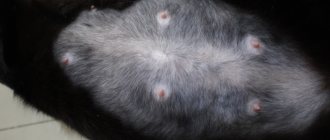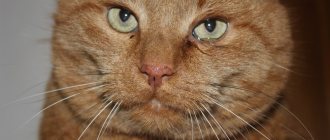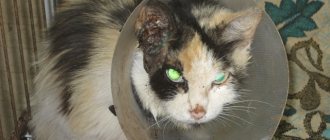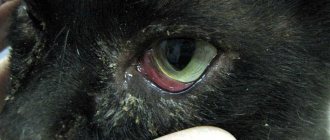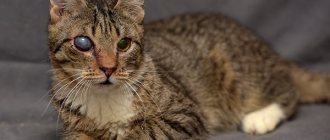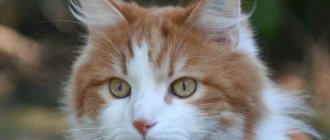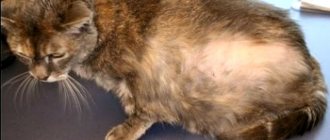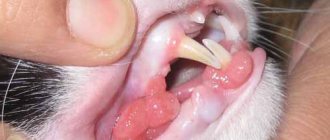Eye diseases of cats
Diseases affecting the eyelids of an animal include:
- Inflammation of the eyelid (blepharitis).
- Wounds and bruises.
- Entropion or inversion of the eyelid.
- Ptosis (drooping of the upper eyelids).
- Lagophthalmos (fusion) of the eyelids.
- Neoplasms.
affect the eyeball :
- Conjunctivitis.
- Glaucoma (high blood pressure).
- Cataract.
- Dermoid (neoplasm in the conjunctiva).
- Dislocation of the eyeball.
- Corneal ulcers and inflammation.
- Keratitis.
Entropion (etropion)
This is a congenital or acquired pathology in which the skin fold of the eyelid, most often the lower one, turns inward due to weakening of the ligamentous apparatus. As a result of inversion, the eyelashes and fur come into contact with the cornea of the eye.
At first, the kitten experiences slight discomfort, and the presence of the disease can only be guessed by profuse lacrimation and slight redness.
Then inflammation and swelling appear, due to which the eyelid changes its appearance, photophobia, cloudy mucous discharge from the eyes, the tissues of the eyelids become hot and swell, and the eyes do not open. In the future, volvulus contributes to the development of chronic conjunctivitis and keratitis. Advanced cases lead to corneal ulcers.
Prolonged mechanical irritation of the eye can lead to serious complications, including blindness or loss of the eye, so treatment (surgical) must be timely. After anesthesia, your pet needs to be provided with quality care.
The animal's eyes are watery: reasons
Tearing can occur either from natural causes or as a result of illness.
In the first case, tears from the eyes may appear:
- After the furry animal woke up. This is a normal reaction of the body. The cat removes traces of tears itself by washing its face. For kittens, you can wash their eyesight with a swab moistened with boiled water.
- If the cat belongs to a certain breed. The Persian, the British, the Sphinx have tears and a peculiarity of the body. Persians are too fluffy, and doctors often diagnose the Sphynx breed with a disease called “entropion.” In this case, the animal can only be cured by resorting to surgery.
- If hair fibers get on the cornea. This symptom often occurs in long-haired small carnivores. The only thing that will help your cat is regular eye care.
In the second case, the cat may cry due to:
- Mechanical damage, injuries. A pet can damage the eyelid, eye, or cornea in a confrontation with another representative of its breed, during play or a walk. A sharp blade of grass or a twig that scratches the organ of vision can cause serious inflammation.
- Foreign objects. A small speck, a piece of tree bark, or a piece of plastic is enough to cause an inflammatory process to develop in a cat’s eye. Treatment in this case includes procedures for treating with solutions of antibacterial drugs.
- Burn. Curious animals often stick their noses into everything they find at home. Aggressive household chemicals, solvents, and wood varnish can become an object of curiosity, which will lead to a chemical burn. A pet can get a thermal burn if it becomes interested in cooking in the kitchen.
- Allergic reaction. Allergies are the scourge of the modern world; not only people, but also animals are susceptible to manifestations of allergies to various irritants.
- Incorrect eyelash growth. Sometimes a cat has a pathology - the eyelashes grow incorrectly, causing the pet a lot of suffering: the eyelid is inflamed, tears constantly ooze. In this case, the help of a veterinarian is required.
- Helminth infections. One of the signs of the disease is increased production of tears.
- Conjunctivitis. The infection is caused by chlamydia; only a veterinarian can cure the little predator.
- Colds. A cat often cries if it has a cold.
Be sure to read:
A cat refuses to eat: reasons, why it’s dangerous, first aid, what to do, how to increase the animal’s appetite
Causes and symptoms of eye diseases in cats
The most common diseases in cats are:
Inflammation of the eyelids . With phlegmous inflammation, the eyelid swells and purulent mucus flows from the eye. With normal inflammation, the cat begins to scratch its eyes. The eyelids become red and thickened. The disease appears due to vitamin deficiency, eczema. Phlegmous inflammation develops after strong calculations and deep wounds.
Bruises and wounds . A cat can receive these injuries from a fall or after a fight. The wound can be superficial, deep or through. The main symptom is severe swelling, redness and even bleeding from the eyes.
Turn of the century . The skin turns inward. This causes a strong inflammatory process. Volvulus can be caused by a foreign body getting into the cat's eye or exposure to chemicals. Without timely assistance, the cat may develop conjunctivitis or keratitis. In advanced cases, an ulcer will appear on the cornea.
Symptoms of the disease include lacrimation and photophobia. The eyelid begins to swell, changing its appearance.
You can recognize the listed eye diseases in cats from photos.
Types of conjunctivitis
Conjunctivitis is considered the most common disease among cats. It has the following varieties:
- Purulent.
- Allergic.
- Acute catarrhal.
- Follicular.
With purulent conjunctivitis, the general condition of the cat worsens. The animal's body temperature rises, and copious pus begins to discharge from the eyes. Diarrhea and vomiting may occur.
Allergic conjunctivitis in cats is caused by contact with an allergen. At first, the discharge from the eyes appears clear. If left untreated, they become purulent.
Acute catarrhal conjunctivitis is always accompanied by redness of the eyes and severe swelling. Cats experience pain, tears flow, and serous-mucous discharge occurs. The main reason is injury and lack of vitamin A in the body.
Follicular conjunctivitis is characterized by inflammation of the lymphatic follicles. They are on the inside. The disease is chronic and requires long-term treatment. Surgery is possible.
The photo clearly shows all types of conjunctivitis.
Types of keratitis
Keratitis is a disease of the cornea of the eyes. The most common types are:
- Superficial purulent.
- Vascular superficial.
- Purulent deep.
With superficial keratitis, the upper (epithelial) layer of the cornea becomes inflamed. The cat is in pain and afraid of light. The cornea takes on a gray color and swelling develops. This type of illness usually occurs due to injury.
With vascular keratitis, capillaries grow into the upper layer of the cornea, causing clouding of the eyes.
Purulent deep keratitis is a very serious disease caused by microbes that have penetrated the stroma of the cat’s cornea. The cat begins to be afraid of light and scratches its eyes continuously. The cornea takes on a yellowish tint. Capillaries begin to grow into the cornea. The cause of the disease is considered to be injury and infection. The cat will be sick for a long time.
Corneal ulcer
To this disease. Causes infections that develop after deep wounds. This may also be a complication after suffering purulent keratitis. There are 2 types of ulcers: perforated and purulent. The main symptom is severe pain. Therefore, the animal is always restless.
When a perforated ulcer appears, purulent discharge from the eyes is noticeable. The cornea takes on a gray tint. Spasms of the eyelids and fear of bright light are often observed. After treatment of ulcers, scarring will be visible.
Glaucoma
Glaucoma in cats can be acute or congenital. The main symptom is increased eye pressure. The cornea becomes cloudy, loses sensitivity and becomes colorless.
The eyeballs harden and increase in size. The cause of the disease may be hemorrhage, dislocation and swelling of the lens, a complication after suffering purulent keratitis.
Cataract
Cataract is clouding of the lens. It can be congenital, toxic, traumatic, symptomatic.
At the last stage, the pet has difficulty seeing in the affected eye. The lens becomes white. The disease develops as a result of infection, injury or inflammation. Older cats often suffer from cataracts.
Conjunctivitis in cats
This disease manifests itself in inflammation of the conjunctiva, a thin mucous tissue located between the eyelid and the eyeball. There are many factors contributing to the development of the disease: from colds and the presence of parasites in the body to allergies and exposure to chemicals.
INTERESTING TO KNOW: Asthma in cats: symptoms and treatment
Characteristic signs of the disease are inflamed eyes, discharge from them (initially transparent, then purulent green or yellow). Often, a cat’s eyes cannot open when waking up due to pus sticking together the eyelids. The fur around the eyes sticks together.
Conjunctivitis has several types:
- Allergic. Caused by contact with an allergen. Tears flow from the eyes, which, if left untreated, turn into pus.
- Catarrhal acute. It is characterized by redness, swelling of the eyes, mucous discharge and increased lacrimation.
- Follicular. In addition to the mucous membrane of the eyelid, the lymphatic follicles located on the inside of the eyelid also become inflamed.
- Phlegmous. One of the most severe forms. Pus is not only released outside, but is also located in the subepithelial layer of the entire conjunctiva.
- Purulent. Purulent mucus is released from the eyes, there is a general deterioration in the condition caused by the inflammatory process, and the temperature rises. Vomiting and diarrhea are common.
What to do in such cases and how to treat it at home? Therapy for conjunctivitis consists of regularly washing the eyes with a warm decoction of calendula or strong brewed tea and using chloramphenicol drops or tetracycline ointment. Not one eye should be treated, but both, even if there is no inflammation on the second eye.
It is not recommended to use potassium permanganate or furatsilin, as an error with the dosage can lead to a burn of the conjunctiva. You should also not use plain water for rinsing, as this will disrupt the microflora of the eyes, and chamomile decoction, which promotes baldness of the eyelids.
Cotton fibers increase lacrimation, so it is better to use cotton swabs.
About the reasons
The cat's eye is swollen. Why does suppuration and swelling of the eyes occur in cats, while the cheek and nose are also not in the best shape? The third or white eye is a sign of infectious diseases. It is possible that this happened when the cat got into a fight defending its territory.
On the forum of animal lovers they discuss this problem and confirm that there is a reason for everything and in this case these are:
- Injury
. When the eye is swollen, this may be the cause of the blow. An accidental collision of the head with a hard object causes swelling. Of course, this is difficult to determine, since cats do not bruise. - Entry of a foreign body. The eye began to swell and at the same time pus was oozing from it and the tumor site was hot. The object may be debris, sand or wood chips. The main thing is that you don’t need to try to pull it out yourself, but rather contact a specialist.
- Conjunctivitis, glaucoma or other pathology
. The cause of a swollen eye can also be this kind of disease. It is not difficult to identify these manifestations: the pet cannot orient itself in space and a slight touch with this place brings pain to it. You should not delay contacting a veterinarian. - Oncology
. Oddly enough, neoplasms are also found in animals. The cat loses vision, as a result of which coordination of movements in space is disrupted. An examination by a specialist is required to verify this factor. - Blepharitis
. The eyelid is inflamed and pain occurs with slight pressure. But if hard tissue is detected in the area of the eyeball, you should not delay visiting a specialist. - Inversion and inversion
. If the kitten has swollen cheeks and swollen eyes, this may occur due to curled eyelashes. That is, the eyelashes get into the eyes and stick to the cornea. At the same time, rubbing of the eyeball begins, a white film appears and the eye begins to fester. On the contrary, when the eyelid circumference begins to crack, which leads to swelling and inflammation. - Pathologies of the heart muscle and kidneys
. A cat's eye is swollen and swollen, and this is not necessarily a consequence of exposure to external factors, but may also be a disease of the internal organs. Due to their insufficient work, swelling occurs.
In any case, you should show the cat to a specialist and you should not treat it yourself; you can only cause harm to the animal.
Treatment of cataracts in cats
photo from the site: veteye.skycover.ru
Such a dangerous disease as cataracts (or clouding of the lens) requires immediate contact with a veterinarian, who will choose treatment tactics, determine its duration and select medications.
This is interesting
Most often, owners of older animals turn to a specialist with this problem. The reason for the development of the disease is a decrease in the water level in the lens, where cholesterol, protein that cannot be dissolved, and other substances begin to be deposited.
Sometimes cataracts are caused by:
- diabetes;
- severe injuries suffered by the pet;
- poisoning
How can you tell if your cat has serious vision problems?
The main symptom of the disease is cloudiness of the lens, a change in its color (it becomes gray or bluish).
As mentioned above, you cannot self-medicate. Contact your doctor and get recommendations according to which treatment will be carried out. The most common way to help a sick animal is surgery. However, at the initial stage, the veterinarian may prescribe various “feedings” for the eye in the form of vitamins, “Gamavit” or phytomines.
Treatment of eye diseases in cats
There are a huge number of remedies available to treat eye diseases in animals. Diseases can be easily cured with antibiotic ointments and drops. You can use a solution of potassium permanganate and furatsilin for washing.
For eye drops you can use:
- chloramphenicol;
- gentaimcines;
- colbiocin;
- Ciprobid.
Experts do not recommend using Albucid. These drops cause a strong burning sensation.
You can quickly heal wounds with Actovegin (Solcoseryl) gel. It should be placed behind the eyelid.
You can treat cat eyes with tetracycline, erythromycin and neomycin ointment.
For serious problems, in addition to topical medications, the antibiotic Cefazolin is used. It is administered intramuscularly, previously diluted in novocaine. Only the veterinarian determines the dosage.
Together with antibiotics, it is recommended to take Tavegil or Suprastin . These are antiallergic drugs. They are presented in the form of tablets and injections.
You cannot treat eye diseases in an animal yourself. If you use the wrong drug and treatment regimen, this can lead to blindness of the animal.
Treatment of eye tumors
When examining the animal, the doctor determines whether the cornea and eyelid are swollen, whether there is discharge and what type it is, whether there is pain or redness. The sooner treatment is started, the faster the recovery will occur; every lost day increases the risk of complications.
In each case, the veterinarian will tell you what to do to make the cat feel good again. If a foreign body is detected in the eye, the doctor will remove it with sterile tweezers and treat the organ with Furacilin solution.
Treatment for a tumor caused by injury will depend on the severity of the disease. At the veterinary clinic, the eyes are washed and, if necessary, a 2% Novocaine solution and antimicrobial drops are instilled. In case of severe complications, even surgical intervention is possible. For a speedy recovery, it is recommended to feed your cat with vitamin A.
Redness of a cat's eye
For conjunctivitis, regular eye rinsing, drops and ointments are prescribed. For infectious diseases, if necessary, the doctor prescribes antibiotics and immune drugs. This will avoid complications and more severe diseases. Medicines are used only for their intended purpose and according to the instructions that come with them.
If a dense tumor is found in the eye area and the animal has a high temperature, an urgent biopsy is required. The test results will show whether the tumor is benign or malignant. If necessary, surgery to remove the tumor is prescribed.
Cancerous formations
One of the most difficult reasons why a cat has a swollen cheek is cancer. Moreover, about 3% of tumors appear in the oral cavity. Of course, this leads to difficulties with food consumption, and in some cases does not allow the animal to breathe normally. At the same time, the cat is drooling heavily from its mouth.
You need to act quickly and decisively. Otherwise, the risk of lung damage remains - the tumor produces metastases, which makes treatment almost impossible.
Most often, such problems arise in animals living with owners who have the habit of smoking at home. Unfortunately, furry pets are very sensitive to toxic substances contained in cigarette smoke.
Another factor that increases the risk of malignant tumors is excessive consumption of canned food. Yes, according to veterinarians, if canned food accounts for more than 50% of the diet, the animal may well develop cancer.
In most cases, such problems occur in older cats - 10 years and older. But sometimes this can happen to younger animals too.
Treatment is determined by the doctor depending on a number of factors. Surgical removal of the tumor with radiation and chemotherapy is usually prescribed.
Detailed description of common causes
If a cat has a swollen upper eyelid, then first of all the possibility of congenital pathologies associated with abnormal eyelash growth is excluded. If there is swelling in the lower eyelid and there are signs of inflammation, then consider options with blepharitis, which can be caused by a bacterial or fungal infection. But, before making a diagnosis, it is imperative to exclude the following possible causes of this symptom:
Blepharitis. An inflammatory process caused by injury, an allergic reaction or bacterial infection. With blepharitis, a cat's eyelids almost always become swollen and there is discomfort caused by excessive tearing due to stuck together eyelashes. In many cases it occurs together with conjunctivitis. Blepharitis is not considered an independent disease; its appearance is always provoked by something, so symptomatic treatment is ineffective. This is especially true for cases associated with congenital pathologies (third eyelid prolapse). Once the cause is eliminated, swelling and redness almost always subside. As a preventive measure, eye drops with anti-inflammatory and antibacterial effects can be prescribed.- Foreign body. Plant seeds, weed thorns or cactus needles can also become embedded in the mucous membrane of the eyelid. Therefore, if a cat has a swollen eyelid, then the option of a splinter should be ruled out first. The danger of foreign bodies is that they can injure the cornea during blinking. This can lead to the development of uveitis and keratitis. In many cases, owners manage to get splinters out on their own without the help of a veterinarian. But, to eliminate the possibility of infection, all instruments (usually tweezers are used) must be thoroughly treated with an antiseptic solution. After this, you can use antibacterial and anti-inflammatory drops for 2-4 days. In difficult cases, surgical intervention is required. If you ignore the problem, then everything can end with purulent conjunctivitis and keratitis, due to which the pet’s quality of vision may decrease.
Injury. Most often, damage to cats occurs after street fights. In pets, such injuries occur after active games or falls from a height. Therefore, if a cat’s eyelid is swollen after a blow, then you should consider the option of a hematoma or bruise, which most often goes away on its own within a few days. During this period, much attention is paid to the eye itself. At the slightest suspicion of purulent discharge or souring of the eyes, it is recommended to immediately contact a veterinarian.- Abnormal eyelash growth. This is when one or more eyelashes grow incorrectly from birth, thereby injuring the cornea. Because of this, an inflammatory process begins, which results in redness and swelling of the eyelid, cornea and white of the eye. Associated symptoms include increased lacrimation and purulent discharge from the eyes. If the problem is neglected, the development of uveitis and deep keratitis cannot be avoided. The best solution to the problem of double rows or abnormally growing eyelashes is hair removal.
- Turning of the eyelids. Most often found in decorative breeds (Maine Coon, exotics, Scots, British). In Persians, this defect is considered congenital, so it manifests itself already in the first months of life. This manifests itself in the fact that the eyelid turns inward, thereby irritating and injuring the cornea. At the initial stage, the problem will manifest itself in slight swelling and redness of the eyelids, lacrimation. If the issue is not resolved at this stage, then there is a high probability that complications will appear in the form of clouding of the cornea and purulent discharge from the eye. Conservative methods, unfortunately, are ineffective, so the best option is considered to be surgical intervention, during which an incision is made and excision of eyelid flaps. After suturing, nothing else touches the cornea. Complete healing will take 2 to 4 weeks.
In kittens aged 2 to 6 months, the eyelid may become swollen due to respiratory viral infections. But complications affect both organs of vision at once. In case of a single lesion, the option of trauma and congenital pathologies of the eyelid is considered (especially in Persian cats).
The most common diseases
The eyes are an extremely delicate organ. A cat can damage them after an unsuccessful jump or another street fight with representatives of its species.
Important! If you are sure that the cat suffered an eye injury after a walk, examine the rest of the body. Your pet could be the victim of a rabid animal. Rabies can be fatal within a few days. Moreover, your pet can infect you. Contact the specialists!
The cause of such changes in the functioning of the cat’s visual organs can be infections and hereditary diseases. If you have even slight suspicions, you should immediately contact your veterinarian. Perhaps the disease is in its early stages, and treatment will not take much effort or money.
Causes of swollen eyes in cats:
- mechanical injuries;
- allergy;
- contact of foreign objects with the mucous membrane of the eye;
- conjunctivitis;
- glaucoma, cataract;
- change in the position of the eyelid;
- infectious, viral disease;
- tumor.
Injuries
Traumatic swelling of the eyes can be seen in active cats after another unsuccessful acrobatic performance or after a comic fight with a fellow cat. Very often, adult kittens, when flirting, get a paw in the eye from their older comrades. Cats are smart animals that know how to calculate strength. Don't worry, if the swelling and redness are slight, the eye will recover after a while.
Cold compresses can help facilitate recovery. Add foods and food that contain vitamin A to your cat's menu. It helps speed up regenerative processes.
Monitor the changes: if your cat begins to secrete copious amounts of fluid and the tumor continues to grow, contact your veterinarian immediately. Such symptoms are observed when the cornea is damaged. Without timely intervention, this leads to partial loss of vision.
Allergy
We are what we eat. This aphorism can also be applied to our smaller brothers. If you don’t know what to do if your cat’s eye is swollen, try to find the cause in his diet. A new food, an exotic type of meat, one of your pet plants - all this can cause an allergic reaction in a cat. Consult your veterinarian, he will analyze your cat’s diet and help you create a diet.
Allergic reactions also include swelling after insect bites. Cats are very inquisitive, playful animals. They often play with flying insects. Wasps and bees can also be a source of entertainment for a playful kitten. The result is a swollen eye for several days. To reduce itching and burning at the bite site, apply cold compresses.
Foreign objects
If you find a foreign object in your cat's eye, think twice before removing it yourself. One careless movement can cause your pet to lose the ability to see. Do not poke into the eye with bare hands under any circumstances; use sterile gloves and tweezers. Prepare a solution for rinsing the eye after the procedure. For these purposes, use furatsilin and boiled water.
If the animal is in critical condition, call specialists to your home. In this case, carrying out treatment on your own is extremely risky. Several thousand are not worth the loss of such an important sense organ as vision.
Conjunctivitis
Conjunctivitis occurs in a cat's eye due to infection. The main symptoms of this disease are constant discharge of pus and fear of light. Before going to the clinic, experts advise rinsing your eye several times a day to slow down the development of symptoms. For these purposes, use specialized drops, a weak solution of potassium permanganate, boric acid, black tea, and chamomile decoction.
Conjunctivitis is often a symptom of a more serious illness, so consultation with a veterinarian is necessary in any case. The doctor will examine the animal and prescribe the necessary tests.
Glaucoma
A sure sign of glaucoma is a noticeable increase in the size of the eyeball. This occurs due to increased pressure of the eye fluid. To treat this disease, ointments and drops are prescribed. Do not try to choose medications on your own. Your pet may have an individual intolerance.
Cataract
Cataracts are a disease that affects almost all older cats. It is characterized by slight swelling of the eye and clouding of the pupil. If you notice these symptoms, then you no longer have time to think about what to do if your cat has a swollen eye. Immediate surgical intervention is needed. Don't waste time.
Changing the position of the eyelid
This symptom may be a consequence of other ophthalmological diseases. The inversion of the eyelid goes away on its own after some time. To speed up the process, you can use soothing ointments and drops. If the eyelid does not return to its original position after a long time, surgery is performed.
Infection
This concept covers a wide range of causes of redness and swollen eyes in cats. Keep in mind that some infectious animal diseases that are caused by parasites can be transmitted to their owners. Protect the sick animal from people with weak immune systems and children. Visit your veterinarian regularly. Constant surveillance allows you to track the dynamics of the disease and provide effective treatment.
Tumor
Feel around the cat's eye. If there is a solid formation there, this is a reason to sound the alarm. Pets are not immune to tumor development. The sooner you contact a veterinarian, the better the chance that the tumor will not have to be removed surgically.
What to do if your cat has a swollen eye?
If a cat's eyes are swollen, the owner can provide first aid to his pet before going to the veterinarian. To alleviate the suffering of the animal, you need to moisten a cotton swab in strong tea leaves, chamomile decoction, a weak solution of hydrogen peroxide, boric acid, potassium permanganate or a solution of furatsilin. A wet swab is carefully applied several times around the eyelid. If there are crusts, they will become soggy and easy to remove.
The procedure is carried out several times a day to achieve a positive result. For a tumor under the eye of a cat, if it is accompanied by purulent discharge, tetracycline ointment helps. A small amount of the product is carefully placed under the lower eyelid. If none of the methods helps, and there is no improvement, then the animal should be urgently shown to a veterinarian.
It is forbidden to massage or rub the diseased organ of vision, so as not to increase the suffering of the pet.
Possible causes of eye tumor in a cat
A tumor under a cat's eye can occur for several reasons. Cats are inquisitive and difficult to keep track of. An infection could have entered the animal's body; the tumor could have been caused by poor care or low immunity. The cause of the tumor can also be inflammation of the eyelids, the tissues around the eyes are hot and tense. Swelling around the eyelids may indicate problems with the excretory or cardiovascular system.
Injury
The cause may be a head hit on a hard object if the animal is active, runs and jumps a lot. The root cause of the damage may also be a fight with another cat. When injured, swelling appears under the eye. The animal behaves restlessly and the eye may become watery. This reason is difficult to determine, because there is no bruise after the injury. If the injury occurs in the presence of the owner, then a cold compress can be applied to the bruised area.
If a bruise occurs, a wound may appear; if it is not deep, it will heal on its own. In case of deep wounds and bleeding, it is necessary to urgently apply a bandage to the diseased organ of vision and show the pet to a doctor.
Foreign body
A foreign body, a midge, a speck or sand, could get into the eye. In addition to the tumor, purulent discharge or tears may appear. It is not recommended to pull out a foreign body on your own; it is better to contact a specialist at a veterinary clinic.
Conjunctivitis
The cause may be conjunctivitis, how to help, the eye is swollen and causes pain to the pet even with a slight touch. In addition to swelling, redness of the mucous membrane and tearing are observed. With this disease, purulent yellowish mucus is released. After sleep, the eyelids stick together, the animal hides from the light.
In this case, you should urgently contact a veterinarian to alleviate the pet’s suffering. The disease is caused by an infection that can also be transmitted to humans. The animal should be protected from communication with children; it should not be allowed into sleeping areas or personal hygiene items.
Tumor
Swelling in the eye area may indicate the presence of a neoplasm. At the same time, the cat is poorly oriented in space, because his vision decreases. The tumor will be hard to the touch, and the animal's temperature will rise. Only an examination at a veterinary clinic will allow you to make an accurate diagnosis and prescribe the necessary treatment.
Classification
There are several of them. By type of process there are:
- Inflammatory. These include conjunctivitis, keratitis, keratoconjunctivitis, iritis (the iris is damaged), inflammation of the lacrimal canal, etc.
- Not inflammatory. Injuries, bruises, foreign bodies entering the eye, entropion of the eyelids, cataracts, glaucoma, etc.
According to the course of the process, the disease can be acute, subacute and chronic. In the subacute process, the symptoms do not disappear completely, but only subside slightly, while the danger of vision deterioration remains. This course is no less dangerous than acute or chronic, although it seems that the animal has gotten better.
They are divided into:
- Primary – eye problem – this is the underlying disease.
- Secondary - the organ of vision reacted in response to concomitant pathology. For example, when a cat is infected with bacteria, in addition to other organs, the eyes are also affected, which manifests itself in the form of conjunctivitis. In this case, it is necessary to identify the disease that caused this condition and treat the animal comprehensively, and not just deal with the symptoms.
Acne
If you are wondering why a cat's cheek is swollen, then the reason may lie in this disease.
On your cat's lips and chin there are large sebaceous glands that produce keratin. If its amount becomes too large (usually due to other diseases or poor nutrition), then the element clogs the sebaceous glands, in the place of which acne appears. They look like ordinary bumps, leading to swelling of the cat's cheek.
Usually it is easy to determine pathology by eye. The treatment is quite simple, and if you start it on time, then no problems will arise later. It is necessary to treat the skin with antibacterial cream. In the most advanced cases or recurrent illness, antibiotics may also be needed. In this case, therapy becomes more complex and lasts up to three weeks.
Keratitis in cats
An inflamed eye in a cat may be a sign of keratitis, which refers to inflammation of the cornea. It is not difficult to recognize: a healthy eye has a shiny and transparent cornea, while a sick eye has a cloudy, rough cornea.
The causes of the disease can be injuries, infections. There are three types of keratitis:
- purulent superficial,
- vascular superficial,
- purulent deep.
With purulent superficial, the epithelial layer of the cornea is affected. The animal develops photophobia, the eyes swell, and the cornea takes on an unhealthy gray tint.
Vascular keratitis of the eyes in cats is characterized by the growth of capillaries into the upper layers of the cornea, which causes clouding of the eye.
The development of purulent deep keratitis is facilitated by microbes that penetrate the corneal stroma. This is the most serious form of the disease. The cornea becomes white-yellow, capillaries grow into the cornea.
INTERESTING TO KNOW: If there is blood in a cat’s urine, take immediate action
It is difficult to cure keratitis, and the prognosis is not always favorable. Hormonal, antimicrobial drugs, and antibiotic eye drops are indicated.
Causes
Veterinary experts distinguish 2 main categories of causes of eye diseases:
- Disturbances in the functioning of protective organs and the eyeball itself. These include various injuries and burns, inversions and eversion of the eyelids, fusion and drooping of the eyelids, eye loss, blepharitis, neoplasms;
- Pathology of the organ of vision itself. These are: glaucoma, cataracts, conjunctivitis, keratitis, iritis, panophthalmitis, uveitis, etc.
All of them require urgent veterinary care, as they can become chronic, which is either very difficult to treat or incurable, and the organ will have to be removed.
Main causes of swollen eyes
Firstly , injury. Surely everyone knows that when struck, the affected area swells noticeably. This phenomenon is called traumatic edema. Often the swelling is the only visible sign that your cat has hit his head hard. After all, animals don’t have black eyes.
Secondly , if the eye is not just swollen, but also hot to the touch, and exudate is oozing from it, then with a high probability it can be assumed that some foreign object has entered it. It could be a plant thorn, sand, or something else. Do not try to remove this item yourself, as you will most likely only harm your sick pet.
Thirdly , there is a possibility of conjunctivitis or other inflammation affecting some parts of the eyeball. But glaucoma is especially dangerous in this regard. It develops against the background of increased intraocular pressure, and the value of the latter is such that the eye noticeably “bulges” to the side. Signs of this particular pathology are a pronounced pain reaction, disorientation of the animal in space and other clinical manifestations.
How to help your pet?
A few simple safety measures will save the health, and maybe even the life, of your family pet. It is important to adhere to the following rules after identifying a tumor under a cat’s eye:
- Do not take any therapeutic measures on your own. If swelling under the eye is detected, you must visit a veterinarian and adhere to a further course of treatment;
- Applying a cold compress to the sore eye can relieve your pet's suffering. In this case, the swelling will subside a little, after which it is important to show the cat to a specialist;
- Massaging and rubbing the eye is prohibited! Such measures will only increase the cat’s suffering and cause further development of the pathology;
In the desire to help your beloved cat get rid of painful sensations, it is important not to harm. Carrying out home procedures after consultation with a veterinarian will contribute to a speedy recovery of your four-legged friend.
Symptoms of diseases
Among the most common are the following diseases.
Conjunctivitis
It is characterized by the presence of an inflammatory process on the mucous membrane of the eyelids. One of the most common in cats.
There are several types: catarrhal, purulent, ulcerative, follicular. It occurs as a result of various reasons: foreign bodies, vitamin deficiency, injuries, as a consequence of many infectious processes. For example, a common runny nose.
This pathology is manifested by redness of one or both eyelids, their swelling and lacrimation. This picture is typical for catarrhal type; with purulent form, the symptoms are the same, but more pronounced and, in addition to the copious secretion of tear fluid, purulent discharge appears. The swelling can be so severe that the eyelids hardly open, and they also stick together, making it difficult for the cat to open them.
When the process is advanced or immunity is reduced, a rise in local or general temperature in the animal is possible. With follicular conjunctivitis, in addition to the described symptoms, regional lymph nodes located in the inner corner of the eyes are affected.
Cataract
Characterized by clouding of the lens. Older animals are more susceptible to this disease, but young animals can also develop it as a result of infection.
Main symptom: decreased vision. The pet becomes slower and more careful, loses orientation in an unknown environment, and crashes into everything.
Dacryocystitis
Inflammation of the lacrimal sac. It is divided into acquired and congenital. This disease develops as a complication after others, such as injuries or infections.
All age categories of pets are susceptible to it.
The main symptoms are: swelling of the conjunctiva, lacrimation, redness in the corners of the eyes, the lacrimal sac increases in size, temperature rise, and pus is released when pressed. The cat becomes restless due to severe pain that develops with this disease.
Manifestation of keratitis
Keratitis
This is an inflammation of the cornea. It occurs as a result of other pathologies: conjunctivitis, thermal burns, infections, allergic reactions, vitamin deficiency, injuries and congenital predisposition.
Some cat breeds are most susceptible to keratitis, for example, British, Siamese and Persian, American Smooth-haired.
It is characterized by clouding of the cornea and swelling of the upper eyelid. Blood vessels become noticeable as red streaks, and pus accumulates in the corners of the eyes. The cat stops liking the light, begins to squint and hide in dark places.
An ulcer of the cornea of the eye occurs for a number of reasons: chemical burns with cleaning and disinfection products, ingrown eyelashes, trauma, damage by viruses and bacteria. Breeds with flat faces and protruding eyes are more susceptible.
Symptoms: the organs of vision become red and as if “cloudy”, copious discharge, the pet constantly scratches his eyelids, trying to relieve the itching and squints, bright light becomes unpleasant for him.
Third eyelid (loss)
This is a nictitating membrane, which is a protective device. It serves to protect the animal's eyes from mechanical damage and foreign bodies. It can be seen on a pet without special tools; it is thin, almost transparent, light skin near the inner corner of the eye. It helps in moisturizing the eyes. Present in cats, birds and some mammals.
Its loss is characterized by spasms of the eye muscles (uncontrolled closing and opening of the eyelids, their twitching), redness, lacrimation, suppuration with the formation of crusts.
The disease is similar to an adenoma, and therefore you should definitely consult a veterinarian, since if treated incorrectly, it can develop into keratoconjunctivitis. This disease cannot be completely cured and the animal will have to suffer from it for the rest of its life.
Prolapse of the nictitating membrane develops for various reasons, the main ones:
- conjunctivitis;
- eye injuries;
- diseases of internal organs and systems;
- allergic reactions;
- the presence of parasites and helminths;
- fungal skin infections.
Sometimes situations arise when the third eyelid falls out in only one of the eyes, this is often caused by debris getting under it, injuries or a unilateral bacterial infection.
If this situation is bilateral, then most likely the reason is the fusion of part of the eyelid with the eyeball, conjunctivitis or helminthic infestation.
Blepharitis
This is inflammation of the eyelid. It is divided into: simple, ulcerative, scaly, meibomian.
If you notice redness in the eyelids of your pet, you should immediately contact a veterinary clinic. This simple, at first glance, condition very quickly turns into an ulcerative form, and this is already a serious disease.
Manifestation of blepharitis
If this pathology is left untreated, the pet may even lose an eye, as the infection spreads directly to the organ of vision. Panophthalmitis develops, a disease that is often the reason for the removal of an animal’s eyes due to the lack of effectiveness of conservative treatment.
Causes of lacrimation in cats and dogs
Excessive tearing is not normal. This condition can be caused due to the following reasons:
- The most common reason why a cat's eyes water is due to physical discomfort. These can be foreign bodies - dust, sand, plant seeds. There may be irritating substances - smoke, chemical solutions. If a foreign body gets into the animal's eyes, the normal physiological reaction will be a copious secretion of tear fluid, which will wash the foreign body out of the eye. And once it is completely removed and there is no damage to the eye, the tearing will quickly stop. The goal has been achieved - the body has gotten rid of a foreign body that has gotten inside the eye, for example, a speck of dust or a hair.
- Another reason why a dog's eyes are very watery may be a deformation or change in the condition of the tear duct. This can occur as a result of congenital pathology of the canal, or it can also happen after mechanical injury to the eyes. The reason why a dog's eyes are watery may also be an inflammatory process. When an inflammatory process occurs (conjunctivitis), even blockage of the tear duct may occur. This provokes the release of a large amount of tear fluid. In this case, you will observe that the animal’s eyes have turned red, and the tear has become cloudy and has a yellowish or greenish tint.
- If your dog's eyes are watery or your cat's eyes are watery and purulent , the animal is most likely developing an eye infection. In this case, you need to show your cat or dog to a veterinary clinic specialist to find out why your pet’s eyes are watering , what caused the inflammatory process and how to treat it . Eye infections can cause irreversible consequences - the animal can go blind or lose its visual organs, so it is necessary to immediately begin proper therapy. And this, as you know, can only be done by an experienced veterinarian. Infections - the most common in cats - are herpesvirus infection, chlamydia, toxoplasmosis. In dogs, infectious diseases rarely manifest as inflammation of the eyes.
- Allergy. If you notice that your cat is sneezing and its eyes are watery , this is most likely due to an allergy. Take a closer look at your pet. You will probably notice how the animal tries to rub its eyes with its paw, thereby exposing them to additional injury. Remember, one of the main symptoms of an allergy is that your cat's eyes become very watery and experience constant itching in the eye area.
- Anatomical defects are most commonly seen in dogs. These include inversion and eversion of the eyelids and distichiasis (double row of eyelashes). Typically, these pathologies are specific to certain breeds of dogs, but can occur in dogs of any breed. Spitz often as a result of eyelashes and fur often growing incorrectly in their eye area, causing constant discomfort and irritation. In cats, these ophthalmological disorders are much less common than in dogs, but this can also happen. When inverted, the eyelashes are in close contact with the cornea, scratching and “cutting” it. As a result, the same inflammation and swelling develops, and the organ often becomes severely festered. When eversion occurs, the “insides” of the eyelids dry out, crack, and therefore become inflamed and swollen.
- Such a pathology as a violation of the outflow of tears, in most cases, occurs in cats. As a result of this disorder, tear fluid accumulates on the surface of the eye and overflows over the edge of the eyelid onto the muzzle. One gets the impression that the animal’s eyes seem to be running. At the same time, due to constant moisture around the eyes, a dark coloration of the fur and crust appears. Normally, tears wash the cornea and collect in the inner corner of the eye, where the tear lake is located. From the lacrimal lake, tears enter through the lacrimal puncta into the lacrimal ducts, then into the lacrimal sac, and from there along the nasolacrimal duct into the nasal and oral cavities. When there is an obstacle to the outflow of tears, lacrimation occurs. Obstacles can be observed in any part of the lacrimal drainage system, for example in the area of the lacrimal openings; possible inflammation of the lacrimal sac (dacryocystitis); compression of the tear ducts by swelling or swelling as a result of injury.
For diagnosis, a special fluorescein test is performed. To do this, a colored solution is dripped into the cat’s eyes and the time after which it appears in the nasal or oral cavity is noted. Under normal conditions, this process takes 1-5 minutes. If after 5 minutes the solution is not detected in the nose or mouth, this indicates a violation of the patency of the lacrimal ducts. Let us immediately reassure you that if your cat’s eyes are watery for this very reason, then you have nothing to worry about, and what to do with the animal after passing the test. Let us note once again that this problem is mainly of an aesthetic nature.
- Weak immunity. If the pet is too small and fell into human hands too early, the problem may be a weakened immune system. A proper diet is the key to the health of any animal, and thoughtless changes in diet can cause a cat’s eyes to start watering profusely . In this case, adjusting your diet and adding immunostimulating drugs will help. Only a veterinary clinic specialist can prescribe them. Do not prescribe the drug yourself, but seek professional help.
- Parasites in pets. The reason why a cat's eyes are watery may also be helminths. In order to avoid this, it is necessary for preventive purposes to regularly, once every 6 months, carry out antiparasitic therapy. A veterinary clinic specialist will be able to select the appropriate anthelmintic drug for your animal in the required dosage.
- A cold can also cause excessive tearing in your pet. Here the picture of the disease is very similar to an allergic reaction. If a cat is sneezing and its eyes are watery, or the animal is coughing, this is one of the clearest indicators of a cold, and you will definitely need advice from a veterinarian . Also pay attention to your pet’s appetite, how much the cat sleeps, and how much water the animal drinks. The veterinarian will ask you all this before prescribing the correct treatment.
- Eye diseases. Unfortunately, cats, like humans, suffer from eye diseases such as cataracts. You can notice this if the lens of your pet's pupil turns white. Here, of course, you also cannot do without a doctor. Treatment of this disease requires careful examination and subsequent surgical intervention.
- Tumor. Considering the constantly growing number of oncology, we should not exclude the possibility of a tumor, including a malignant one. If a cat's eye is swollen and watery , then this symptom may also indicate the growth of a neoplasm... Unfortunately, with neoplasms of malignant etiology, the cat may completely lose vision, there will be a loss of coordination, and a change in the animal's mood. You are unlikely to be able to find out about the tumor on your own, and therefore we recommend urgently seeking help from a veterinarian.
- Blepharitis. This is the scientific name for inflammation of the eyelids. With this disease, you will observe swelling of the animal’s eyelid. If you try to even lightly press an animal’s eye, you will immediately understand from the pet’s behavior that it is in pain. At the beginning of the disease and in mild cases of the disease, there will be a slightly noticeable redness on the eyelid, which may even go away spontaneously. If the cat’s immunity fails to cope on its own, the next phase of the disease will occur. The animal's eyelids will become heavy, swollen, puffy, and very hot and tense to the touch. Behavior will also change. The cat will become sedentary and inert. Most likely, she will spend most of her time lying down with her eyes closed, since even blinking in this situation causes pain to the animal, and sometimes, due to severe swelling, the eyelid simply does not open.
- Pathologies of the cardiovascular and excretory systems. This can also cause a cat's eye to water; What to do in this case - immediately undergo a full examination of your pet at a veterinary clinic. The fact is that if the functioning of the heart and kidneys is disrupted, then edema quickly develops in the body. And if we see external swelling, then most often we don’t even know about swelling of internal organs.
Prevention of eye diseases
To avoid eye diseases in a pet, the owner must prevent them. It is necessary to monitor the cat’s health, its behavior, nutrition and the state of the gastrointestinal tract. It is important to keep the entire house clean, including your cat's dishes and litter box. Dust and dirt can easily get into your pet's eyes and cause illness.
Your pet should be given a balanced diet to improve the immune system.
It is necessary to care for your pet, comb its fur and examine it regularly in order to identify the disease at an early stage.
To strengthen the immune system and protect against infectious diseases, cats need to be vaccinated in a timely manner. It is recommended to vaccinate from childhood so that adult cats can tolerate diseases more easily.
It is not recommended to self-medicate to prevent complications. Eyes are one of the most sensitive organs; with timely treatment of diseases, vision loss can be avoided.
How to treat a cat's eyes if they hurt, and how to understand that help is needed?
photo from the site: murlyka.net.ua
Most often, at the initial stage, the animal may not experience pain, and the only thing you can do is regularly examine the pet to eliminate the risk of infectious infection and prevent suppuration and inflammation, wash its eyes and remove discharge from them.
If you notice the slightest changes, immediately take your pet to the nearest veterinary clinic - the doctor will make a diagnosis and prescribe a course of treatment with mandatory examinations as it progresses.
Diagnostics
It is carried out by a veterinarian in a specialized clinic, as it requires special tools. It is carried out in several stages. First, the organ is examined and the following parameters are assessed:
- preservation of vision;
- appearance of the organ: the size and shape of the pupils, their symmetry; the same parameters are used to evaluate the eyelids and their condition;
- condition of the eye: its size, shape, position relative to the orbit, absence or presence of injuries.
After an external examination of the organ, the doctor begins research using additional equipment: examines the fundus of the animal, measures intraocular pressure, prescribes general clinical and biochemical tests of blood and urine, takes a smear to identify pathogenic microflora and its sensitivity to antibiotics, etc.
Symptoms of hair loss
The emergence of the third eyelid beyond its normal boundaries, as well as its swelling, is a serious cause for concern. The non-physiological position of the membrane is a signal of certain diseases or injuries. In addition to the fact that the third eyelid becomes visually noticeable, other symptoms are noted. In cases where the causes of the unpleasant phenomenon are directly related to the eyes, redness of the conjunctiva occurs, the release of an increased amount of tear secretion, the appearance of purulent discharge in the corners of the eyes, and involuntary spasm of the orbicularis oculi muscle. A burning sensation in the eyes affects the cat's behavior. She tries to avoid the light and scratches her eyes with her paws.
If the problem is caused by systemic or infectious diseases, then the cat will exhibit symptoms characteristic of such conditions. These include general weakness, decreased activity, loss of appetite, and increased temperature. If the problems are related to the digestive tract, then frequent or episodic vomiting and diarrhea are possible. As the process drags on, the animal loses weight and the condition of its coat deteriorates. In rare cases (with Horner's syndrome), paralysis or paresis of the limbs and facial nerve occurs.
Sometimes third eyelid prolapse is confused with lacrimal gland prolapse because these conditions are visually similar. To distinguish these problem situations and understand the solutions, it’s worth watching this useful video:
Treatment
Most eye diseases are treated conservatively. To do this, use various drops and ointments containing antibacterial agents. Before placing or instilling them, wash the animal’s eyes with a weak solution of furatsilin or potassium permanganate.
The most popular are products based on Tetracycline, Gentamicin, Erythromycin and Levomycetin.
They try not to use Albucid to treat pets, as it burns strongly and the animal will not allow it to be instilled anymore.
After applying the ointment or drops, you should hold the cat in your arms for a while, otherwise it will wipe off all the medicine with its paw.
If there was an injury, Solcoseryl ointment (Actoveginovaya) helps well for healing; it is applied to the inside of the eyelid.
In advanced stages, antibiotics are administered intramuscularly or intravenously, depending on the condition of the animal and the tolerability of the procedure.
In order to exclude allergies to injected drugs, a course of antihistamines, for example, Suprastin or Tavegil, is prescribed.
They try to resort to surgical treatment in extreme cases or when it is not possible to preserve the organ of vision. For example, with panophthalmitis, this is often the only treatment option.
What treatment is prescribed?
If a kitten or adult cat has a swollen cheek due to an insect bite, then first of all you should find and pull out the sting, then apply a cold compress near the bite site. Sometimes an animal develops an allergy to the poison, which then causes symptoms such as suffocation, increased body temperature, weakness, and lethargy. If the veterinary clinic is far away, the cat should be given an antihistamine injection on its own and then taken to the hospital.
When an abscess forms, the cavity must be cleaned of pus, after which the wound is washed, and a course of antibiotics is prescribed to destroy the bacterial infection. You cannot do without antibacterial drugs for gumboil and inflammatory dental diseases. Sometimes the veterinarian will advise removing the diseased teeth or cutting the gum and clearing it of pus.
After the tumor is removed, the animal is treated with chemicals.
For muscle inflammation, a course of non-steroidal anti-inflammatory drugs and glucocorticosteroids is prescribed. Additionally, painkillers and warm compresses can be used. If there is a malignant neoplasm, the doctor will prescribe surgery, after which a course of chemotherapy and rehabilitation will be prescribed. Hematoma often does not require special treatment. Over time, the formation will disappear on its own; it is only important to ensure that it does not become inflamed.
To support the cat’s immunity during the therapy period, the doctor prescribes vitamins and mineral complexes.
Prevention of ophthalmic diseases in cats
Before getting a pet, think about the responsibility that falls on you. After all, the health of a pet depends on how strong its body is at an early age, what conditions it is in, what kind of nutrition it has and how well it is cared for.
To avoid unpleasant diseases and ensure a trouble-free existence for your animal, you must do the following for preventive purposes:
- Vaccinations. Timely vaccination will strengthen your kitten’s immunity, after which infectious diseases will no longer be so scary for an adult cat.
- Nutrition. When a cat’s diet is balanced, not only does its immune system improve, but also its appearance, playful mood, and digestion.
- Care. Daily brushing and examination of the cat will prevent any disease, because the disease does not begin suddenly, but with some preliminary incubation period.
If the cat owner does not have sufficient qualifications, then you should not self-medicate. After all, the diagnosis may turn out to be incorrect, and improper treatment can only worsen the disease. It is better to contact a veterinarian once again, since the vision of your pet is at stake, which should bring joy and comfort to your home, and not anxiety and regret.
Swollen eyelids in a cat are always an alarming symptom. It cannot be left unattended - the animal must be shown to a veterinarian-ophthalmologist as soon as possible.

